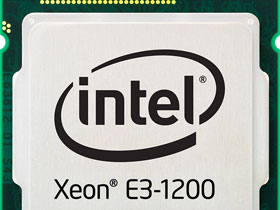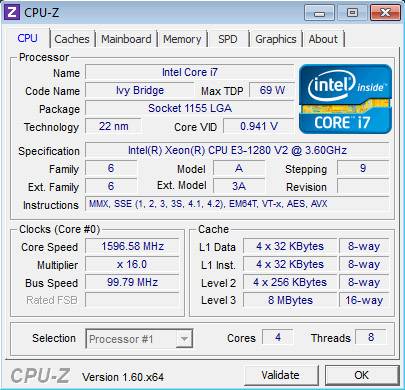Intel Xeon E3-1280 v2 Review: Ivy Bridge Goes Professional
Intel recently introduced its Xeon E3-1200 v2 CPUs, based on the Ivy Bridge architecture. Though they're very similar to the third-generation desktop Core chips, ECC memory support, four extra PCIe 3.0 lanes, and attractive pricing grab our attention.
Ivy Bridge Finds Its Way Into Servers And Workstations
Not long ago, we took a look at Intel’s Xeon E5 family in Intel Xeon E5-2600: Doing Damage With Two Eight-Core CPUs. In that story, we saw the company expose its Sandy Bridge-E design the way its architects originally intended: armed with eight cores, 20 MB of shared L3 cache, and QPI links cranking away at 8 GT/s. That was a far cry from the desktop Core i7-3960X we reviewed previously, neutered back to six cores and 15 MB of L3 cache—particularly since our Xeon E5-based platform was running in a dual-socket configuration in Altered Beast mode.
Now, Intel is replacing its entry-level Xeon E3s, formerly based on the Sandy Bridge architecture, with models that employ its Ivy Bridge design.
There aren’t any dormant processing cores or blocks of shared L3 cache to make the new Xeons really pop this time around. Intel instead relies on a couple of unique business-oriented features and creative pricing to make its Xeon E3s shine.
How’s this for an example? Right now, Newegg is selling the Core i7-3770 (with a locked multiplier) for $320. A Xeon E3-1240 v2, which runs at the same 3.4 GHz, doesn’t include processor graphics, and bears a 69 W thermal ceiling, goes for $280. Same speed, no useless graphics, lower power consumption, and $40 less? Color us intrigued.
The Benefits Of Workstation-Class Hardware
Today, however, we’re looking specifically at Intel’s Xeon E3-1280 v2, which is higher up in the stack. Just 100 MHz faster than Intel’s quickest desktop-oriented model, Core i7-3770K, E3-1280 v2 sells for a pricey $612. The -3770K is a much more palatable $332. How do you justify the Xeon over the Core i7 when you know they’re both based on the same Ivy Bridge architecture?
That’s a difficult argument for an enthusiast to make. But in some environments, the difference in pricing is truly inconsequential compared to the few benefits enabled by the Xeon. Compared to the desktop parts, Intel’s Xeon E3s support ECC-capable memory, for example, catching and correcting memory errors that could either take a business machine down or affect critical data.
Get Tom's Hardware's best news and in-depth reviews, straight to your inbox.
These new Xeons also enable four additional lanes of third-gen PCI Express connectivity. A chip like Core i7-3770K exposes 16 lanes, total. The Xeon E3s offer 20, which can be used as single x16 and x4 links, or across two x8 slots and one x4 interface. The former configuration would work well in a workstation with discrete graphics and an add-in storage or networking controller. The latter is decidedly better for server setups, supporting more high-speed devices over an 8 GT/s bus.
Some of the other benefits that Intel cites are less relevant to our look at the -1280 v2, but better as you descend the product family. For instance, there are 11 total Xeon E3 models, allowing for broad differentiation. All but two models support Hyper-Threading, and all but two come equipped with 8 MB of shared L3 cache.
Current page: Ivy Bridge Finds Its Way Into Servers And Workstations
Next Page Intel’s Second-Gen Xeon E3 Processor Family-
aqualipt Meeeh, Ivy bridge is a disappointment for the hardcore PC users, although is great for mobile users.Reply -
tomfreak ReplyIvy Bridge Goes Professional
Need Ivy Bridge Goes budget.
Still Waiting this.... i3, Pentium G -
bit_user Skip.Reply
I went with a Sandybridge E5-1620 + discrete graphics. Twice the memory bandwidth. Twice the PCIe lanes. Comparable price. And the raw performance of the cores is only a couple % slower. A good tradeoff for GPU compute.
-
mousseng Okay, I'll take your word for it that a $600+ Xeon can be better value in certain scenarios than an i7. But how exactly is it better value than the ~$230 E3-1230v2, which (as far as I can tell) is exactly the same, only clocked a few hundred MHz lower? Is the need to squeeze every ounce of performance out of the server-class CPUs so great that Intel can demand a $400 price hike for 300MHz?Reply -
The 3Ds Max test doesn't make any sense unless you mention which renderer you're using (Mental Ray? Vray? Scanline?). Also it would be nice if you compared against desktop processors to see if it's worth splashing out on the XeonsReply
-
PreferLinux Skeletor1The 3Ds Max test doesn't make any sense unless you mention which renderer you're using (Mental Ray? Vray? Scanline?). Also it would be nice if you compared against desktop processors to see if it's worth splashing out on the XeonsYou don't buy Xeons for performance, you buy them for reliability. The performance for clock speed is exactly the same.Reply -
PreferLinux moussengOkay, I'll take your word for it that a $600+ Xeon can be better value in certain scenarios than an i7. But how exactly is it better value than the ~$230 E3-1230v2, which (as far as I can tell) is exactly the same, only clocked a few hundred MHz lower? Is the need to squeeze every ounce of performance out of the server-class CPUs so great that Intel can demand a $400 price hike for 300MHz?If you need the single-threaded performance, you need it. You can't get that performance by combining multiple systems. In servers or render farms, you can just add a few more machines to make up for the lesser performance, because they are dealing with tasks that are extremely well threaded – so you don't buy the fastest option, you buy the best value option. But in some cases, the single threaded performance is more important (certain workstation tasks) or you are limited to one system (many workstation tasks), so the performance matters more than value until the performance stops making a significant difference.Reply
And I wouldn't say that it is better value, rather I'd say that it is necessary for the extra reliability. -
mandrilux Nice review, but i'd like to view a comparasion between E3-1245v2 or E3-1275v2 versus I7-3770 or I7-3770K over a motherboard with chipset Z77 like Asrock. Because the E3 is cheaper than I7 and supports same socket.Reply
Thanks. -
mandrilux Nice review, but i'd like to view a comparasion between E3-1245v2 or E3-1275v2 versus I7-3770 or I7-3770K over a motherboard with chipset Z77 like Asrock. Because the E3 is cheaper than I7 and supports same socket.Reply
Thanks. -
ekho Intel doesn't compete hard these days.Reply
It does whatever it wants.
AMD or ARM-BASED are not serious competitors at least for about next 2 years I guess.


